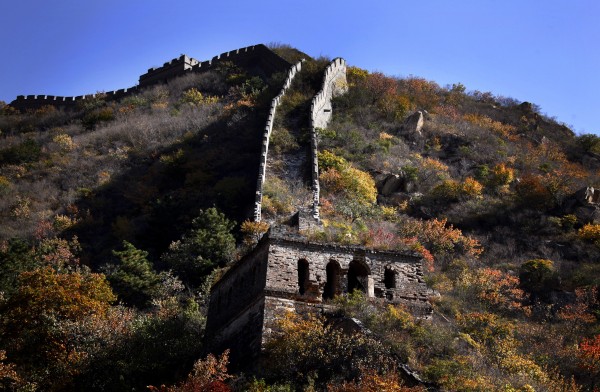The Great Wall of China Is Falling Down, Experts Warn
| David Perry | | Aug 22, 2014 01:34 PM EDT |
(Photo : Reuters) Far from pristine condition, several lengths of the Great Wall of China are in desperate need of repair.
It is the most recognizable symbol of China, and it is falling apart, experts warn.
Built continuously from the 3rd century BC till the 17th century AD the Great Wall of China was a straightforward military defense against nomadic raiders from the Siberian steppe. Visited by almost four million admirers a year, the barrier is a showcase of Chinese ingenuity and a must-do photo-op for every diplomatic envoy swinging through.
Like Us on Facebook
But that has not stopped vast stretches of the wall to crumble. The preservation status of the Great Wall is "not optimistic", a Chinese expert has said, highlighting irresponsible industrial development and a lack of funds.
"Almost three quarters of the part of the wall built in the Ming Dynasty is poorly preserved, and less than 10 percent is in a relatively sound condition," said Wu Guoqiang, secretary-general of the China Great Wall Society, at a seminar last week.
The irony of the statement is that the Ming sections of the wall are the most recent. The wall as it is known today was built or restored during the Ming era, a period of great cultural advance spanning 1368 to 1644. Several older sections, particularly in the far west of the country are far older and in much worse condition. Lengths that see high tourist numbers, such as those at Badaling in Beijing and Huangyaguan in the port city of Tianjin, are meticulously maintained. However, a length of the wall at little-visited Xiang Shui Hu, located just 50 miles northwest of Beijing is in an advanced state of decay.
An even greater irony is that man, not nature, is proving more detrimental to the wall's future. The Great Wall is not monitored regularly, and Wu revealed that civilians in rural areas pull bricks from the wall for local buildings and even sow crops on it. For all its impressive might, the wall is not particularly strong, often just a rammed-earth barricade with a brick or stone exterior shell.
"Damage from human activity is growing more and more exacerbating," said Wu, citing construction projects approved by local governments with no preservation concerns.
Maintenance often falls to the municipalities through which the wall runs; impoverished regions simply let the wall fend for itself. While developers have been keen to turn China's cities into shiny, LED-spangled metropolises, preserving and maintaining an ancient monument 26 feet tall and 2150 miles long has inspired less enthusiasm, to say nothing of the logistical nightmare it represents.
Fines and imprisonment sentences for particularly grievous vandalism exist, but Wu worries it simply is not enough. For all its fame to the outside world, that the wall is no longer a national security measure makes it seem superfluous to some practical-minded Chinese in towns where bricks, worked stone, or farming land is scarce.
"The Great Wall is the most recognizable symbol of China in the world, and it must be kept alive," Wu said.
©2015 Chinatopix All rights reserved. Do not reproduce without permission
EDITOR'S PICKS
-

Did the Trump administration just announce plans for a trade war with ‘hostile’ China and Russia?
-

US Senate passes Taiwan travel bill slammed by China
-

As Yan Sihong’s family grieves, here are other Chinese students who went missing abroad. Some have never been found
-

Beijing blasts Western critics who ‘smear China’ with the term sharp power
-

China Envoy Seeks to Defuse Tensions With U.S. as a Trade War Brews
-

Singapore's Deputy PM Provides Bitcoin Vote of Confidence Amid China's Blanket Bans
-

China warns investors over risks in overseas virtual currency trading
-

Chinese government most trustworthy: survey
-

Kashima Antlers On Course For Back-To-Back Titles
MOST POPULAR
LATEST NEWS
Zhou Yongkang: China's Former Security Chief Sentenced to Life in Prison

China's former Chief of the Ministry of Public Security, Zhou Yongkang, has been given a life sentence after he was found guilty of abusing his office, bribery and deliberately ... Full Article
TRENDING STORY

China Pork Prices Expected to Stabilize As The Supplies Recover

Elephone P9000 Smartphone is now on Sale on Amazon India

There's a Big Chance Cliffhangers Won't Still Be Resolved When Grey's Anatomy Season 13 Returns

Supreme Court Ruled on Samsung vs Apple Dispute for Patent Infringement

Microsoft Surface Pro 5 Rumors and Release Date: What is the Latest?










